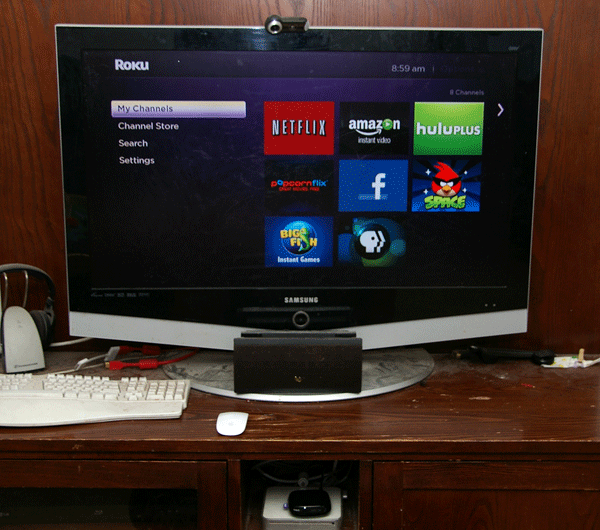Cable and satellite providers have been pushing hard to try and keep their subscribers. What was once a given feature of the family home for watching TV is facing major declines. This comes from the people who are cutting the cord. I was an early adopter of dropping my TV services almost a decade ago in favor of watching TVs and movies through Netflix’s DVD rental services. Now this is becoming a much more popular thing to do especially in the past few years thanks to the recession, a growing number of alternatives and increasing high speed internet access.
What Does Cutting the Cord Mean?
The majority of households in the US receive their television service either through a cable TV provider or Satellite TV service. Previously, people would receive their TV services over a standard antennae referred to as over the air. Cutting the cord simply refers to dropping the standard cable or satellite TV provider. This might simply be because people don’t care to watch any TV anymore for other activities such as video games, watching DVDs or other online social networking.
For many people who cut the cord, it is about getting their TV through more modern means. Typically this involves the shows being streamed over the internet. It might be to a computer, a mobile phone, tablet, gaming system or even their new TV. Of course it could also be a fall back to the traditional antennae which is free and quite functional for those that live near to major broadcast areas.
Why Consider Streaming Over Cable/Satellite?
The biggest driving factor for people leaving cable and satellite services is the cost. The cost of these services has been outpacing inflation for many years. As a result, something that used to cost maybe $40/month ten years ago costs nearly $100. The providers will claim that this isn’t a fair comparison because they are adding more value. This might be because they offer a bundling of additional services such as internet and phone but they are also adding a huge number of extra channels.
The problem with increasing cable costs is the result of channel bundling by the content companies. A great example of this is ESPN. This is a highly viewed cable channel and the Disney company knows this. To expand their revenue and viewers, they started creating additional ESPN branded channels. In order for the satellite and cable providers to get the main ESPN channel, they have to purchase the bundle of channels at a higher price than before. So, now instead of just ESPN, there is ESPN, ESPN2, ESPN News, ESPN Classic, ESPN Spanish, ESPN U, ESPN 3, and ESPN 3D. Ironically, the additional channels cannibalize the viewers away from the main channel and spread them to the other channels which actually causes a decrease in advertising revenue that the creators can charge.
I personally saw this when I cancelled my satellite TV services. Out of the fifty or so channels that I was receiving, my wife and I were watching maybe five to seven with any regularity. Because the cost was getting so high and we were watching more and more DVDs from our Netflix subscription we decided to drop our satellite service. What was costing about $60/month ended up being roughly half the cost by switching to a six DVD at a time Netflix plan.
Flexibility is also a major reason that many people may want to switch away from their cable or satellite provider. With the advent of TiVo and digital video recorders, more consumers were having their devices record the programs when they were airing and then watching them at their convenience. This allowed one to stay up to date with TV shows and allow more flexibility in their social lives. Cable and Satellite providers eventually started to bundle this service with their services as a means to try and add value to their customers and hopefully prevent the rise of sharing programs. The problem is that you are still hooked to that TV and video recorder.
With streaming services, consumers are just extending that ability they had received from their digital video recorders except now they could have that ability in a wide range of locations. Rather than watching shows at the TV, they can watch a streaming video from just about any location that has acceptable high speed internet service and a device that can view the stream.
Finally, some people just want to cut the cord because they want to watch less TV. When you have so many programs available to watch, one can get sucked into leaving the TV running in the background as you wait for a program that you want to watch or just because you are hoping to find something to watch even though you might be doing something else in the room. Many people got into the habit of having the TV running in the background whatever they might be doing. By removing the source of the video, you are also removing that instinct to just leave it on as you have to actively look for what you want to watch.
Now these are all reasons that someone might want to actually cut the cord but what are the obstacles that one would face by switching to getting their TV and movies via streaming? That will be the subject in my next article.


Pingback: Cutting the Cord Part 4 - Streaming Devices | Tech for Anyone
Pingback: Holiday Tech Gifts for $50 or Less - Tech for Anyone
Pingback: Sling TV: A Good Start, But Long Way Still to Go - Tech for Anyone
Pingback: Cutting The Cord Part 2 - Disadvantages of Streaming Only - Tech for Anyone